#very loosely inspired by a junji ito page
Text
Since Halloween draws closer, have a lil spooky fella from a Magma I joined a few days ago :3c
The theme was ‘Amalgamation’
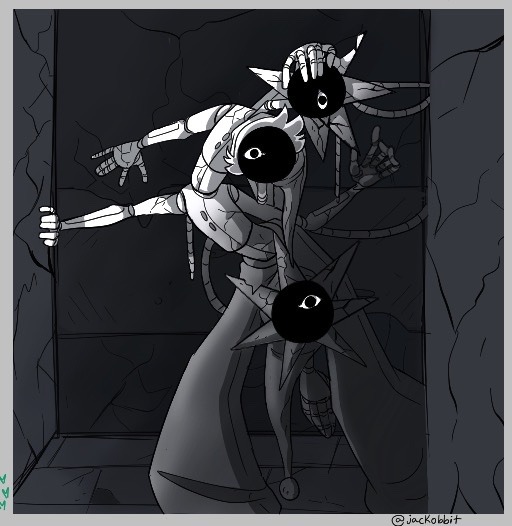
[ID: A Magma drawing in monochrome of Sun, Moon and Eclipse from Fnaf merged together into one being, they approach the viewer in a dark hallway. The creature has three separate heads that hang down throughout the piece, each heads face is blacked out, leaving only one semi-realistic eye in each. The creature has five arms, and two torsos stacked on top of one another. Several wires connect to the amalgamation, some hanging down while others remain attached to something at the end of the hall out of frame. /End ID]
#fnaf dca#fnaf daycare attendant#fnaf moon#fnaf sun#fnaf eclipse#tw body horror#tw eye imagery#moondrop#sundrop#dca fanart#dca fandom#my art#very loosely inspired by a junji ito page#it’s been far too long since I’ve tried to doodle out something spooky#I’m hoping to draw at least one good Halloween inspired drawing#before the holiday at least#depends on how long this model takes me
359 notes
·
View notes
Text
Chorogaiden
I recently got to read through Chorogaiden, and I think folks here may dig it.
Chorogaiden is a 36 page occult horror ttrpg done in a sludgy, low-fi art style. If you're familiar with World Of Horror, it is very, VERY World Of Horror-y in tone and presentation, but with a more loose, story-first approach to its mechanics.
In Chorogaiden, the players and GM work to build an extremely haunted little town that's on the verge of waking up something eldritch and evil, and then the players explore the town and try to avert a weird-horror apocalypse.
Dice rolls are conducted by spending d12s from a player's pool, adding them together, and only gaining one of them back on a successful roll. This gives the game a feeling of attrition, and is paired with a doom track that is incremented by rolling certain numbers and which progresses the game towards that aforementioned apocalypse.
A lot of what makes Chorogaiden work is the GM, as the game relies on a slow escalation of stakes and revelations to make the story feel compelling. GMs that click with the Junji Ito vibes will sort of naturally know how to progress and escalate. GMs that don't, or that are used to much more structured games, might struggle.
However, for GMs that do like slow-burn horror, and improv, and just enough mechanics to really freewheel without the system flying apart, this might be a dream game.
The author, neonrot, also has a wide body of other work---most with a similar sludgy, arcane feeling---so if you're interested in yokai, esoteric card games, or cannibalistic humanoid underground dwellers there might be something to check out there as well.
16 notes
·
View notes
Text
𝕮𝖗𝖊𝖆𝖙𝖎𝖓𝖌 𝖗𝖔𝖙𝖔𝖘𝖈𝖔𝖕𝖎𝖓𝖌 | 23/10/19
During the morning we went to the photography department of the school where we would start the day off there by filming our own footage to rotoscope later on. There were no restrictions as to what we were allowed to do in front of the camera and green screen, but we had to move from one side of the screen to the other. I decided to go for a gun man or James Bond type of vibe. I didn’t want to just do a simple walk or run cycle, but instead I wanted to challenge myself a little. I did this by sneaking into frame, holding my hands up as if I was holding a gun (this added a prop that I would have to draw form scratch during the process of rotoscoping) then doing a turn and running back out the frame. When recording the clips in the green screen room, I also decided to turn around and then turn back while moving to add to the difficulty of animating everything together. This is how both of them turned out:

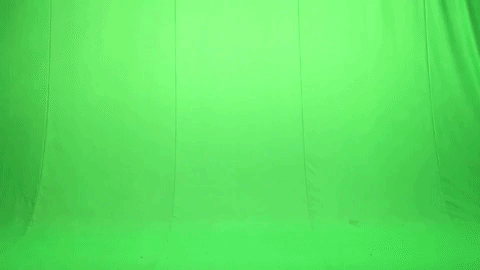
I decided to go with the first of the two clips for my rotoscope. I did this simply because of the turn being slower and therefore making it more challenging to animate the gun to follow the movement in such a way that it won't look “out of place”.
I didn’t find the time during college hours to actually do the rotoscope for this, so I did it at home using my own program (Krita) and my drawing tablet.
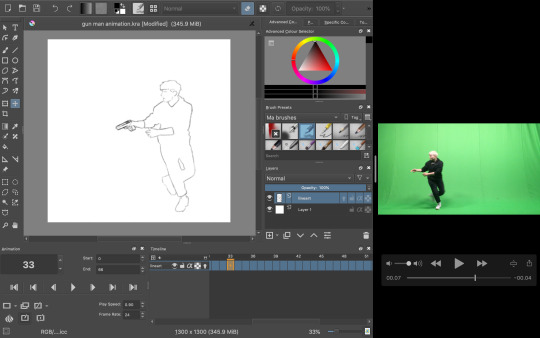
The process was relatively simple; I took the video and took a screenshot of each frame as I went, dragging the screen grab onto the canvas and began tracing my figure. As I went, I also drew in the gun for each frame, lining it up with the position with my hands.
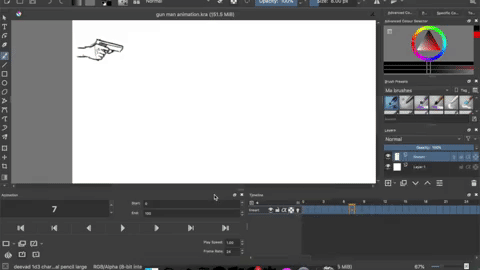
To keep the appearance of the gun consistent I copied most of the frames, up until I came to the part where I had to change the perspective of which the gun is seen from (during the turn).
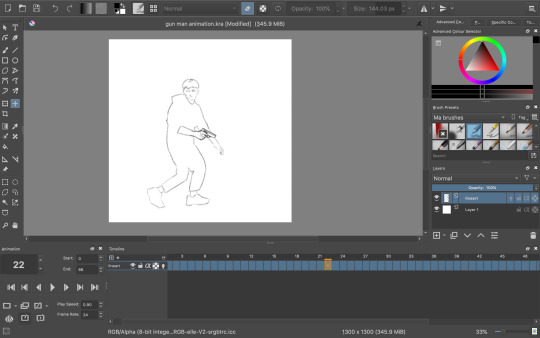
Once I had finished the whole rotoscope this is what I was left with:
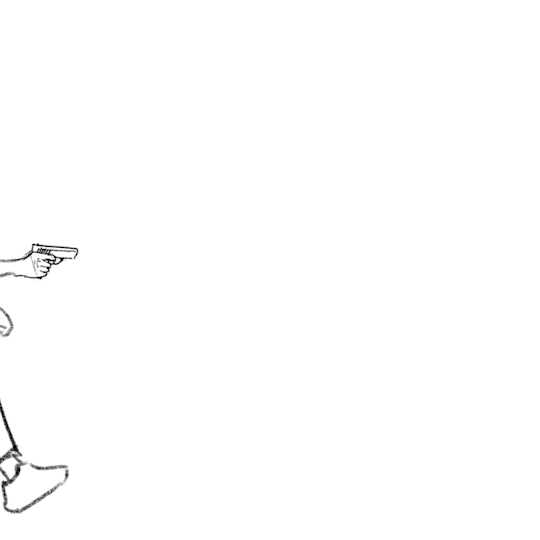
The finished amount of frames came to 66. Quite a high number for such a short animation, but I didn’t want to take away from the fluidity and smoothness. Now I could have just left it here, but I wanted to do some more experimenting. I tried out filling in the clothes with some texture to create a more interesting looking sequence, but half way through I decided to go back to the original linework since I just wasn’t happy with how it was turning out, but here was that in motion:
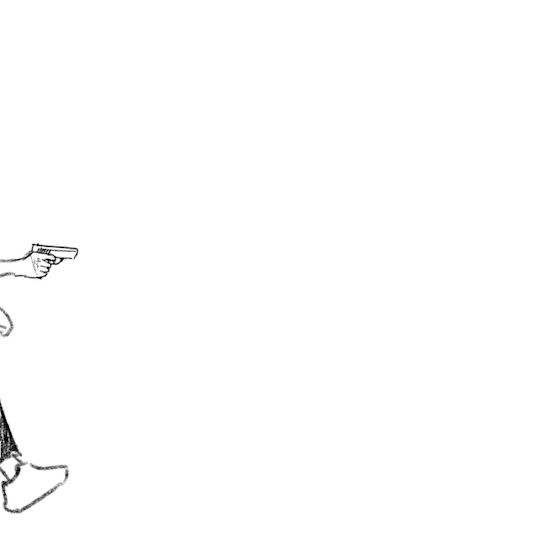
Instead I did a bit of brainstorming, thinking about what I could do to improve what I had already made. Here’s the mindmap of the brainstorm that I did:

So as you can see, I ended up wanting to experiment with depth, leading me to be doing something to the background. Most of the mind map is based off visual language. I found using this as the root for my brainstorm really useful due to the way you can interpret each term differently to whatever the context is. I will definitely be doing this again and experiment with it further in the future.
I had also settled on wanting to keep it monochrome (misspelling in mind map) and more specifically drawing towards the style of the classic black & white manga comic book style. Based on this, what immediately popped into my mind was this program I recall trying out years and years ago called Medi Bang Paint Pro, or as I think it was used to called; Medi Bang. I was probably around 12 or 13 when I first downloaded it, but I didn't know what I was doing what so ever, so I quickly gave up. For a long time it wasn’t compatible with Mac up until recently; so I decided to take a shot and download it again. The program is free; but that wasn’t the main reason to why I wanted to try out this program again in particular. It has a lot of great tools for drawing and building comic pages, and I thought “What would it look like if I made a background inspired by traditional manga?”- so that’s what I did.
I wasn’t sure if I was going to be able to pull it off at first, so I did a little test run beforehand and I really liked the result:

So the way that I did this was by taking a picture (that I unfortunately have lost now) and then proceeding by changing the levels of the picture, playing around with it until it’s primarily just blacks and whites. With a brush tool I began cleaning everything up a little by either erasing unwanted bits or adding additional linework just to emphasise on the subject and shapes within the drawing. I added leaves and other vegetation with some pre-made brushes that came with the program. The last step was to add a screentone of a clouded sky to add a bit of texture, shading and general interest to the whole piece, and voila! Done. This technique is super quick and efficient for creating backgrounds for comics of this style, though I still prefer when everything is painted by hand. The screentone has a very recognisable style to it and is quite often used in manga’s. One of the ones that come to mind for me is Berserk. I have always loved the artwork of that comic series; it’s the kind of art that you could stare at for hours on end and not get bored with. When looking at the artwork from the series, you can clearly see the technique of screentones are being used to create a lot of additional detail to each panel.
Here are some examples of some screentones:
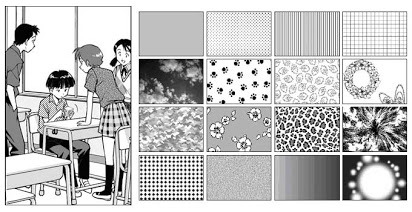
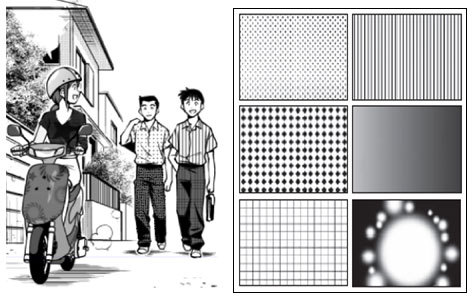

In this example, it has been used for the background. A screentone with blobs lightly shaded has been added to almost create some sort of mist, changing the whole mood and feel of the panel very effectively.

Like mentioned before, in Berserk, the screentones are mostly used as an extra bit of atmospheric detail, rather than being used for any of the shading which is all hand drawn. In this example, it has been used for the lettering/type and again for the background. It creates a gritty and sort of dirty effect, emphasising how he is in a battlefield with monsters around him; definitely not a place you could call “clean”.

In this example, different kinds of sceentones have been used in each panel. In the panel to the left, the opaque stripes are a type of screentone very often used to indicate either speed, focal point or action of some kind. Not only that, but at the bottom of the panel a softer pattern of screentone has been used to create the look of dirt or sand, again with a gritty texture to emphasise on the fact that the character, Guts, is inferior at this moment.
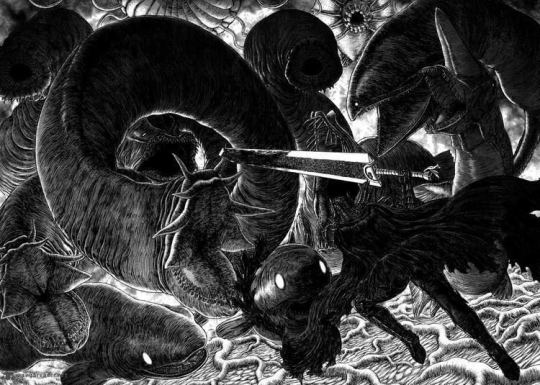
In this super epic and intense illustration, you can again see the great use of screentones, most notably used for the background yet again. It really helps to create a strong feel to each illustration. The use of tone is especially important in manga or comics, since it so often is done in just black & white, so you have no use of colour; this is where screentones come in as a great tool to use for just this.
So, with all of this brainstorming and researching done, and by using the same technique as I did when doing the “test”, I began drawing. I used this picture which I recall taking somewhere on the border to Germany as the base image:

I chose this because it has that “street” vibe to it, which I thought could be cool with the whole theme of “gun man”. Very edgy, very edgy indeed.
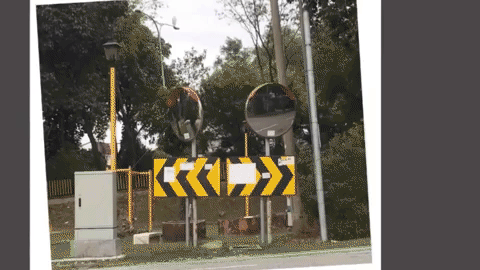
This gif above shows loosely the process of the piece from start to finish. It was mostly just me playing around and figuring out all the tools of the program, but it was quite fun to put together.
With the background now complete, I put it into my rotoscope, went over each frame and painted the shape of myself in the animation white and was finally finished with the final rotoscope; being the third version or option that I did.


I am very happy with how it turned out in the end, and I have definitely learnt masses with this exercise of rotoscoping something that that I have filmed myself. I think if I were to further improve on this, I’d definitely consider animating the background itself (birds flying or leaves rustling), or maybe even try shading the subject somehow, taking inspiration from manga’s such as Berserk or any of Junji Ito’s work.
I decided to try out asking a few of my peers in the class what their opinion was on the final rotoscope. The feedback that I received was purely positive; the people I asked said they couldn't think of any particular way of improving the finished product. They said it both looked great as well as it answered what the task was questioning and challenging us to do.
To me, this really shows and proves that the work I have done here is successful work that I can be proud of and take what I have learnt through doing this task with me for the future, without doubting if what I have learnt is of quality.
✄┈┈┈┈┈┈┈┈┈┈┈┈┈┈┈┈┈┈┈┈┈┈┈┈┈┈
As a little extra note, here are the same frames (frame 23) in the three different versions:

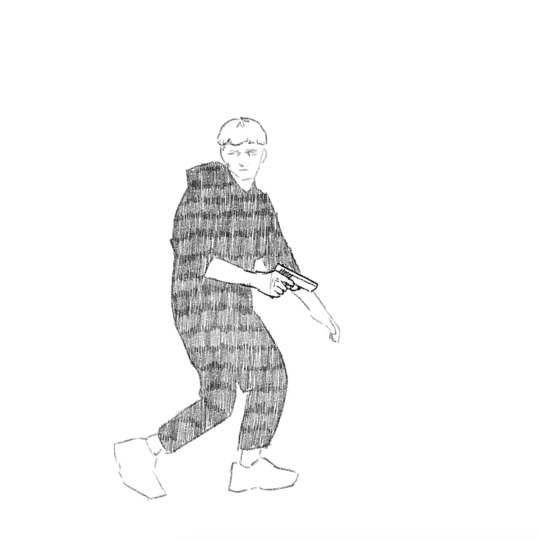

4 notes
·
View notes
Text
My favorite comics of 2017
Keeping with my new tradition of posting this list super late, here, on the last day of 2018, is my best comics of 2017 list. I can offer excuses -- my wife and I remodeled our house and welcomed our first child into the world this year, and I’m also unfailingly lazy -- but 2017 was also a killer year for comics, making this a bit larger of an undertaking than usual. Both Koyama Press and co-publishers Retrofit Comics and Big Planet Comics had absolutely stacked lineups. You’ll see them listed as publisher for many entries below.
I always struggle with how to order this list. I got serious about organizing my comics collection in 2018, and am running into the same problem. There, I’m thinking of dividing it into two -- a single-author section organized by author name (which ends up being mostly minicomics and graphic novels), and a multiple-author section organized by title (which ends up being mostly traditional-sized comics). Here, I’m essentially doing that same thing, but mixing them together; some entries are by title, and some author name.
Comics I especially enjoyed are marked with an *.
Allison, Matthew; Cankor: Calamity of Challenge #2 and #3 (self-published).
Berserker 1, edited by edited by Tom Oldham and Jamie Sutcliffe (Breakdown Press). There was a lot of anticipation and very specific expectations placed on this book ahead of its release, but no one seemed to walk away from the finished product satisfied. But it’s got a killer cover, great production design, and strips by some of the best cartoonists going. I hope Breakdown does another one.
* Booth, Tara; How to be Alive (Retrofit Comics & Big Planet Comics). One of the funniest books I’ve ever read. Booth’s drawings are a riot to look at, that the gags are also great is pure gravy. About as big as crossover hits get in my house. (I.e., my wife also loved it.)
Cardini, William; Tales From the Hyperverse (Retrofit Comics and Big Planet Comics). Cardini’s sci-fi world is made bigger and more engaging by the rapid-fire pace of this short story collection. His wild experimentation with color is always an inspiration.
Corben, Richard; Shadows on the Grave #1 - #8 (Dark Horse Comics). Not my favorite of Corben’s late-period Dark Horse horror books, but there’s plenty to enjoy. I was stunned by the sheer efficiency of the storytelling -- there are entire stories told with a single image and a few word balloons. A lot of these books sport great covers, issue #1 here, seen at the link for this entry, is one of the best.
Darrow, Geoff; The Shaolin Cowboy: Who’ll Stop the Reign? #1 - #4 with Dave Stewart (Dark Horse Comics). I was so bowled over by the experience of buying Shemp Buffet monthly that I initially scoffed at Cowboy’s return to more traditional narrative, but it turned out to be no less wild and no loss at all.
Davis, Eleanor; Libby’s Dad (Retrofit Comics & Big Planet Comics) and You & a Bike & a Road (Koyama Press). You & a Bike & a Road does something that’s often attempted and rarely successful -- it beats the audience down so it can then lift them up higher. Its success is due in no small part from its origin as a real-life journal. The visceral and emotional pain Davis feels on her journey is sincerely felt, and the lack of cynicism the storytelling choices are made with allow the reader to feel it whole cloth. And listen; it certainly doesn’t hurt that Davis is an amazing narrative storyteller besides -- Libby’s Dad is no less affecting.
DeForge, Michael; mini kuš! #43 'Meat Locker' (kuš!). I sleep on DeForge. I take him for granted. I feel like I’m not the only one? I see some excitement when his books come out, but no discussion. Blame it on the high volume and opaque nature of his work, the dearth of comics reviewers, and me, obviously. Also obviously, whenever something of his does find its way to my hands, I’m never sorry.
Estrada, Inés; Alienation #3 - #6 (self-published). The bundled version of this series, seen at the link for this entry, has the coolest book packaging I’ve ever seen in my life.
Expansion by Matt Sheean and Malachi Ward (AdHouse Books). I didn’t like this nearly as much as this same team’s previous Ancestor (due no doubt to its earlier and improvised creation), but damn, what a cover.
* Forsman, Chuck; Slasher #1 - #4 (Floating World Comics). I’d say the majority of my interest in Forsman’s work is in seeing how he presents his it and steers his career -- he’s among the best there is at that. Slasher is his first work I strongly connected with. It digs deep and gets wilder and wilder.
Ferrick, Margot; Yours (2dcloud). I’m a simpleton, so I was surprised at how deeply I was able to be moved by something this abstract. As always, grabbing 2dcloud’s whole line on Kickstarter expands my horizons and makes me a better reader.
Foster-Dimino, Sophia; Sex Fantasy (Koyama Press). I’ve actually only read the minis of this. This collection has the one I’m missing, plus some new material, but I love Sex Fantasy. It’s like a perpetual motion machine for thought -- you can just think about it forever.
Fricas, Katie; Art Fan (self-published). One of those things you dream of happening at a show -- picked this up at MICE not knowing anything about it, and was delighted by the artwork and knocked out by the “reviews of trippy art events”; particularly the first, about Duke Riley’s Fly by Night.
* Friebert, Noel; WEIRD6 (self-published), SPINE: I’ll Still Watch (Bred Press), Old Ground (Koyama Press). Sometimes when I have a fever, I can’t break loose of a single, circular thought -- I have the same thought over and over, only to realize once the fever’s broken that it was barely coherent. Friebert’s newer, decompressed work is like that. You turn page after page, and nothing happens. It’s the same characters still doing and saying the same things, again and again. You turn the pages faster and faster, almost in a panic, hoping to break the cycle and resolve the unease before you. But it’s no use.
* gg; I’m Not Here (Koyama Press), Valley (kuš!). I’m Not Here is one of a few books I recommended to people who were enjoying season 3 of Twin Peaks at the time. It doesn’t convey information so much as emotion, and rewards as much thought as you want to put into it.
* Hankiewicz, John; Education (Fantagraphics Books). I loved this so much I only read a few pages a night to make it last. Michael DeForge once called Noel Freibert an “astronaut” -- that applies to Hankiewicz also. No one’s ever done anything like this before, and if we didn’t have Hankiewicz I don’t think anyone ever would. Bringing poetry and modern dance (!!) into the language of comics, this was another book I recommended to watchers of season 3 of Twin Peaks -- you don’t understand the story by connecting facts, you understand it by connecting emotions.
* Hanselmann, Simon; Portrait, XMP-165 (self-published). XMP-165 was the first big payoff of the longform nature of Megg and Mogg, and it destroyed me. Also released this year was Doujinshi, Cold Cube Press’ gorgeous re-release of a Japanese Megg and Mogg fan comic.
Harkam, Sammy; Crickets #6 (The Commonwealth Comics Company). People talk about how good this book is, and I agree, but I’m not sure I could tell you why.
Haven, Eric; Vague Tales (Fantagraphics Books).
Hernandez, Gilbert and Jaime ; Love & Rockets Vol. IV #2, #3 (Fantagraphics). I made the terrible error after Love Bunglers to trade wait Locas, and for whatever reason they haven’t released one since. So I was way behind when this started coming out, but I bought and read it anyway. I initially found the story to be light, but I eventually realized I had a free ComiXology trial and caught up. It’s as great as ever.
Ito, Junji; Dissolving Classroom (Vertical, Inc.), Shiver: Junji Ito Selected Stories, and Tomie: Complete Deluxe Edition (Viz Media). Tomie may have come out in 2016 actually? I describe it to people as being about a beautiful woman who stands around until some total lech of a man inevitably murders her, then she comes back and annihilates him in the most unpleasant manner possible. Repeat ad infinitum. I don’t think the text 100% supports my reading, but that’s what it means to me.
Landry, Tyler; Shit and Piss (Retrofit Comics). The ephemeral, disjointed nature the single issue format served this story better, but it’s still extremely rad.
Loup, Celine; The Man Who Came Down the Attic Stairs (self-published).
Marcus, Ben; Crisis Zone 3rd Edition (Bred Press).
Mignolaverse and John Arcudi; Dead Inside #3 by Arcudi, Toni Fejzula, and Andre May, Lobster Johnson: The Pirate’s Ghost #1 - #3 by Arcudi and Tonci Zonjic, Hellboy: Into the Silent Sea by Gary Gianni, Mike Mignola, and Dave Stewart (Dark Horse Comics). Ignoring a few years in college when I was a lapsed comics reader, I’ve bought every Mignolaverse comic since I was about 13. That loyalty has slowly eroded over the last half decade about. I’m not alone in thinking the Arcudi-Davis run is one of the greatest of all time, and that the books started to go downhill after Guy Davis left. Beyond the departure of Davis, there are a few reasons for that, in my view.
First was the decision soon after to expand the line’s offerings. Doubling the line’s output and bringing in (inevitably) inferior creative teams was a no-win proposition for readers. Who wants more of something not as good?
Second, I think that Arcudi, a great writer, has shifted his focus from tightly-plotted five issue arcs to series-spanning character arcs. While I’m guessing this reads great in big chunks, it doesn’t spread out month to month, some months out of the year. I’m looking forward to a big re-read of everything after B.P.R.D. wraps in a few months, to see if this theory holds. Lobster Johnson: The Pirate’s Ghost came close to standing on its own, but was still rife with moments that I can only assume were big character payoffs because I didn’t remember enough to know. (Especially cool covers by Zonjic on these issues.) However, the non-Mignolaverse title Dead Inside offered the type of visceral, plot-based payoff his B.P.R.D. run with Davis hooked me with. I hadn’t been this thrilled by an Arcudi book since Killing Ground.
But third, and worst of all, has been the addition of writer Chris Roberson, whose books read like updates to the Mignolaverse Wiki. (The Visitor: How and Why He Stayed was okay, but pretty much solely due to Paul Grist’s fun art and layouts.)
I’m staying aboard the main B.P.R.D. book as it races to the finish line, and will continue to buy anything Arcudi writes, which seems to be mostly these Lobster Johnson comics. (Although even that’s looking increasingly, and sadly, unlikely to continue: https://twitter.com/ArcudiJohn/status/1075086925436874753) And I’ll certainly buy any more of these very sporadically-released Hellboy OGNs, like Into the Silent Sea, they decide to release -- the only real non-Mignola drawn Hellboy books anymore.
* Milburn, Lane; CORRIDORS (self-published). Sits comfortably next to Inflated Head Zone by Zach Hazard Vaupen, one of my favorite comics. They both forsake straightforward narrative in favor of theme-driven emotional impressionism, and do it with horror. This is catnip to me, and something I aspire to (although I’m far too boring to achieve it).
* Mirror Mirror II, edited by Sean T. Collins and Julia Gfrörer (2dcloud).
Now: The New Comics Anthology #1, edited by Eric Reynolds (Fantagraphics Books).
* Providence #12 by Jacen Burrows, Juan Rodriguez, and Alan Moore (Avatar Press). It came out months after, but it’s a safe bet Moore wrote this before Trump got elected, right? A more accurate depiction of the shell-shock of being thrust into a post-facts world I haven’t seen.
Roberts, Keiler; Sunburning (Koyama Press). Another big crossover hit in my house.
* Shiga, Jason; Demon Volumes 2, 3, and 4 (First Second). Demon became a book I wouldn’t stop showing to anyone who would listen. Like Gina Wynbrandt’s Someone Please Have Sex With Me, its hook transcends the normal comics reading audience -- you can show it to anyone and they get it right away. Specifically I would show people this amazing video https://youtu.be/NRxCTeM5pyU, which would clue them into what Shiga does enough to get them to read Demon. Demon has a story, but it’s more about rules -- establishing them and playfully subverting them with a level of inventiveness that regularly leaves you in awe.
* Terrell, Jake; Extended Play (2dcloud). This delightful book took me completely by surprise, an experience made possible by 2dcloud’s subscription model.
Tomasso, Rich; She Wolf: Black Baptism #1 - #4, Spy Seal: The Corten-Steel Phoenix #1 - #4 (Image Comics). The end of this second series of She Wolf approached the same hostile disregard for what came before as the end of Tomasso’s previous series, Dark Corridor. But where Dark Corridor acted on that impulse by simply burning it all down, She Wolf has enough respect at least to replace what came before by pivoting into a completely different comic. The freedom this affords the plot to dart in unpredictable directions is exhilarating. And it’s fun and beautifully laid out and designed, as always with Tomasso.
Tran, Thu; Dust Pam (Peow). Gorgeous!
Vaupen, Zach Hazard; Combed Clap of Thunder (Retrofit Comics and Big Planet Comics).
* Willumsen, Connor; Anti-Gone (Koyama Press). The part where the protagonists drive their boat past a window with a dog in it rewired my comics-making brain forever. This was another comic I only read a few pages of a night to make it last longer, and also recommended to friends of mine who were enjoying season three of Twin Peaks -- the plot is obfuscated in a similar way.
Yanow, Sophie; What is a Glacier? (Retrofit Comics and Big Planet Comics).
Yokoyama, Yuichi; Iceland (Retrofit Comics). Another comic I recommended to Twin Peaks season three fans. Similar to the residents of the Red Room, the characters seem truly of another world, their motivations and actions incomprehensible to us.
2 notes
·
View notes
Photo
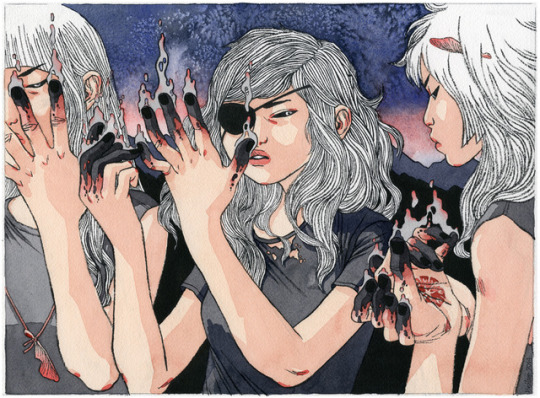

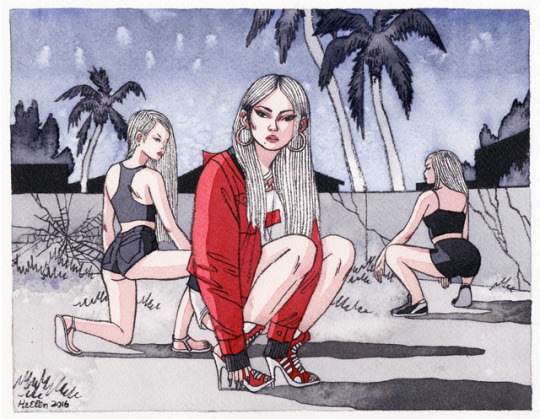
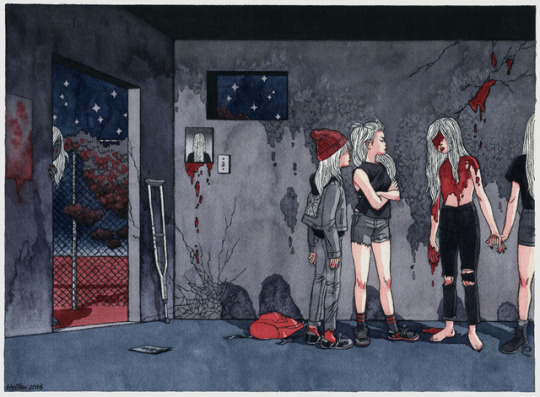
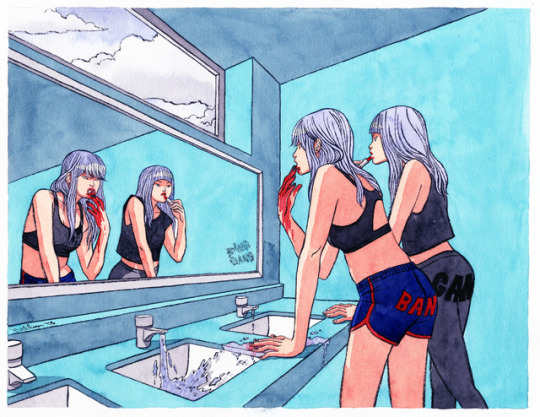
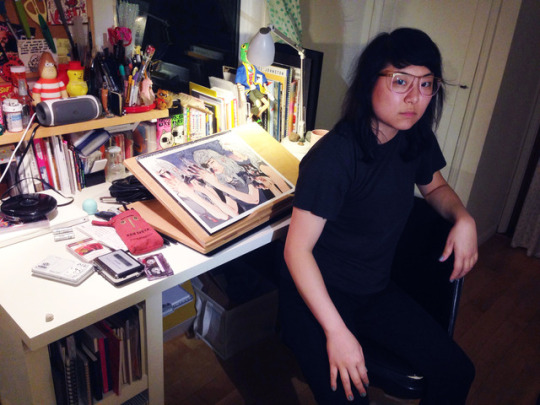

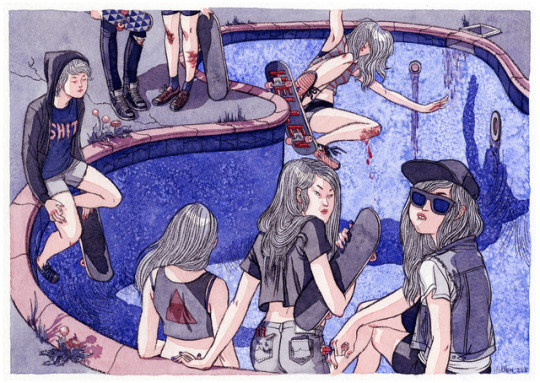

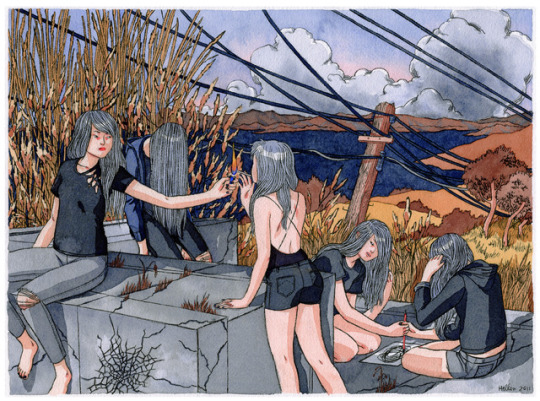
Sketchy Behavior | Hellen Jo
Never afraid to speak and/or draw her mind, Los Angeles based artist and illustrator, Hellen Jo and her characters can be described as rough, vulgar, tough, jaded, powerful, bratty and bad-ass - AKA her own brand of femininity. Known for her comic Jin & Jam, and her work as an illustrator and storyboard artist for shows such as Steven Universe and Regular Show, Hellen’s rebellious, and sometimes grotesque artwork and illustrations are redefining Asian American women and women of color in comics. In fact, that’s why Hellen Jo was a must-interviewee for our latest Sketchy Behavior where we talk to her about her love of comics and zines, her antiheroines, and redefining what Asian American women identity is or can be; and what her ultimate dream project realized would be.
Tell folks a little about yourself. So is it Helllen with three “l”’s? Mainly because your IG handle and website has a whole lot of extra “l”’s?
Haha my actual name is Hellen with two L’s. All my emails and urls contain a different number of L’s to confuse everyone. My grandfather took my American name from the Catholic saint, but he spelled it wrong, and now I share the same name as the mythological progenitor of the Greek people. But I like it better than my Korean name, which literally means, “graceful water lily” HAHAHA. I am an illustrator-slash-painter-slash-I-don’t-know-what living and working in Los Angeles.
Let’s talk about your early childhood / background. I read you’re from San Jose, CA and both your folks were professors, which is really cool!! How did you end up making art instead of teaching a room full of students about Hotel Management or Medieval History? Just curious where you got your “creative bug” and what early comics, arts, and/or influences led you down the road to becoming an artist?
I grew up in South San Jose, and yes, both of my parents are professors, of finance and of applied linguistics. A lot of my extended family are professors too, so I grew up parroting their desire for academia, but really, I started drawing when I was a wee babe, and I’ve always wanted to be a cartoonist. When I was really young, my parents drew for fun, really rarely; my dad could draw the shit out of fish and dogs, and my mom painted these really beautiful watercolor still lifes. I was fascinated, and I’d spend all my time drawing on stacks and stacks of dot matrix paper by myself. My parents also had a few art books around the house, and I remember staring so hard at a book of Modigliani nudes that my eyes burned holes through the pages.
What was the first comics you came across?
The first comics I ever got were translated mangas that were given to me by relatives when we’d visit Korea. I remember getting Candy Candy, a flowery glittery shojo manga for girls, and I was mesmerized by all the sparkly romance and starry huge eyes. I was also enthralled by Ranma ½, a gender bending teen manga that was equal parts cute art, cuss words, and shit too sexy for a kid my age. However, I was mostly thrilled that I could understand the stories with really minimal Korean reading skills, thus cementing a forever love of comics. In junior high and high school, I read a mix of newspaper strips and some limited manga, and I was enthralled with MTV cartoons “Daria” and “Aeon Flux”, but I wasn’t exposed to zines or graphic novels until I moved to Berkeley for college.
Did you have a first comic shop you haunted? What did you fill your comic art hunger with?
Being a super sheltered teen with not-great social skills, I was lonely my first semester, so I would lurk at Cody’s Books and Comic Relief every single day after classes. I read the entirety of Xaime Hernandez’s Love & Rockets volume, The Death of Speedy one afternoon at Cody’s, and it literally made me high; I was so hooked. I amassed some massive credit card debt buying and reading as many amazing comics as I could those first (and only) couple years of school: all of Los Bros Hernandez’s Love & Rockets, Dan Clowes’ Eightball, Julie Doucet’s Dirty Plotte comics, Peter Bagge’s Hate series, Chris Ware’s Jimmy Corrigan, Charles Burns’ Black Hole, Taiyo Matsumoto’s Black and White, Junji Ito’s Tomie and Uzumaki volumes… I could not believe the scope and breadth of the alternative comics genre, and the stories were so insanely good; they literally mesmerized me. I was so obsessed; I even skulked around the tiny comics section at UC Berkeley’s Moffitt Library in search of books I hadn’t read, and amid the fifty volumes of Doonesbury strips, some sick university librarian had included an early English translation of the Suehiro Maruo collection, Ultra Gash Inferno. That book blew my tiny mind about a hundred times; it’s totally fucked up erotic-grotesque horror porn, but the art is unbelievably beautiful. I read that entire thing sitting on the floor in the aisle, feverishly praying to God to forgive my sins after I finished the book, because I was way too ashamed to check it out of the library.
How about zines? I imagine a comic devouring ….
I devoured zines at a nearly equally fervent pace, including those by Aaron Cometbus, Al Burian (Burn Collector), Doris, John Pham, Jason Shiga, Lark Pien, Mimi Thi Nguyen, etc. I had never seen a zine before in my life, and suddenly, I was living in a town full of zinesters. I was drowning in inspiration. I tried to copy the art and writing of everything I read, and I spent a lot of my time making band flyers, trying to pass off zines as suitable replacements for term papers (this worked just once), and making monthly auto-bio comics for a few student publications. Eventually, I dropped out of school, then dropped out of school again, and I made my first published comic, Jin & Jam; then it all became real.
What was your early works like? and how did these become fodder for your self-published stuff later? What about your own experiences did you feel needed to be expressed in your own comics and artwork?
As a kid I was mostly copying sparkly girl manga and Sailor Moon stickers, and I don’t think I’ve really strayed all that far from that. My first few zines were cutesy autobiographical comics about crushes and falling asleep at the library; incredibly dull stuff. I made a super fun split comic/ep with this band I loved, The Clarendon Hills, but after that point, I was tired of drawing cute, goofy shit.
I had also really been obsessed with Korean ghost horror movies in high school, and I wanted to make comics that reflected more of that kind of coming-of-age violence and rage, so I made a couple standalone horror comics, Paralysis and Blister. These were longer than anything I’d ever done (forty to fifty pages each), and I felt like I was finally figuring out how to write interesting stories. I eventually dropped out of school and made Jin & Jam, based a bit on growing up in San Jose and on other kids I had grown up with.
At the time, there were still relatively few Asian American women in comics, and I was tired of whatever hyper-cute, yellow-fever, Japanified shit we were being pigeon-holed into, so I reacted by writing and drawing vulgar girls who started fights and didn’t give a fuck. I went to art school for a few semesters, got better at drawing people, and went on to draw nothing but mean bad girl ne'erdowells. I’d never been a very strong or defiant personality outwardly, but I’ve always been a pretty big fuckin bitch on the inside, and I just wanted to draw how I feel, in the most sincere way possible. And naturally, over the years, as I continued to develop this attitude in my art, I was able to express it better in person as well. Self-actualization through making comics!
For folks who don’t read comics, can you explain why they are SO AMAZING and moving to you! What about the format, art and overall genre makes them so great and not just your typical “funnies.”
I truly believe that comics are the greatest narrative format and art medium of all time! They are completely full of potential; you can draw and write whatever the hell you can think of, there are no real rules, and you as author and artist can create a deep and intimate experience for your reader. You can bare your vulnerabilities or yell at the world or create a visual masterpiece or inform people, visually and narratively. I don’t even believe that good art makes good comics; writing is king, and the art should really serve to further the story. Some of the worst comics I’ve ever seen had the most amazing art, and some of the greatest comics I’ve loved have the plainest, most naive, even ugly visuals, but those authors were able to finesse a symbiotic relationship between the text and the images to tell a compelling story. People are already so drawn to images, so it makes sense to me that they can enhance a reader’s literary experience so much.
I read that Taiyo Matsumoto is one of your all time inspirations. Most folks probably don’t know much about this master of comics, heck my knowledge is limited, so what makes his work speak to you so much? Perhaps it’ll encourage folks to venture into a new world of art exploration through visual comics.
Taiyo Matsumoto is the all time master of coming-of-age comics. I worship at his altar, for real. He is a Japanese artist, so technically his work is manga, but his masterful storytelling and singular visuals are so different from most manga, beyond categorization. He writes quiet, powerful stories about boys, girls, and teens who live in uncaring worlds surrounded by unfeeling adults, but they rise to these challenges and thrive in spite of themselves. The characters feel deeply, and the reader can’t help but ache and rage and celebrate just as fully. The drawings are beautiful and sensitive, with rough, loose artwork consisting of scratchy lines and cinematically composed shots.
What were some of your first memories with his work?
I remember buying the first two Pulp volumes of Black and White (also published as Tekkonkinkreet) at Comic Relief, reading them both at home that day, and then, covered in tears, literally *running* back that evening to buy the last volume before the store closed. I probably cried a dozen times while reading it; it’s a story about two orphan boys who protect each other in a neo-Vegas-like city of vice, but the characters were so brutal and brilliant and poignant. I had never read anything like that before, and it literally made me sick that, at the time, none of his other works were available in English. Eventually, I figured out that he was more widely published in Korea, so on every family trip, I’d run away from my folks for a day and buy as many of his books as I could carry back to the US. I made my way, slowly, through the Korean translations of Hana-otoko, Ping Pong (another incredible favorite!), and Zero. A beautiful collection of short stories, Blue Spring, was published in English, and then VIZ began translating the series No. 5, but they abruptly stopped mid-series due to low book sales. I was so starved for his work that at that point, I’d ebay his art books and comics only available in Japanese and just stare at them. Eventually, Black and White was made into the anime film, Tekkonkinkreet, and Ping Pong was made into an anime mini-series, and his rise in popularity ensured a wider English availability of his work. His current series, Sunny, is being translated and published here, and every volume breaks my heart a million times.
I’m sorry, this just turned into a gushy, gross fan fest, but Matsumoto’s books really changed my entire perspective on how comics can be written and paced, how characters can be developed fully, and how important comics really are to me. I love them so much!!!!!
You’ve worked in so many cool fields such as a storyboard artist and designer, and on various cartoons, such as Steven Universe. For folks who are interested in those fields, what can you tell folks about that? I’m sure like most artists, you’d rather be spending those long hours working on your own personal art, so how do you balance them? How did you move from a comic artist to working as a storyboarding artist?
I stopped working in animation about a year and a half ago, but the transition from indie comics to storyboarding was rough one, for me. I got into storyboarding at a time when a lot of kids’ animation networks were starting to hire outside the pool of animation school graduates and reach into the scummy ponds of comics. In my case, the creator of Regular Show, JG Quintel, had bought some of my comics at San Diego Comic-Con from my publisher, and he offered me a storyboard revisionist test.
Some cartoonists, like my partner Calvin Wong, were able to transition wonderfully; cartoonists and board artists are both visual storytellers, and once they’d learn the ropes, many of them thrived and succeeded. I can’t say the same for myself; I have major time management issues, I draw and write incredibly slowly, and going from working completely alone to pitching and revising stories with directors and showrunners was just a real shock to my system. For most of my time at Cartoon Network and FOX ADHD, I wasn’t able to do much personal work, but I crammed it in where I could.
Storyboarding also requires a lot of late nights and crazy work hours, to meet pitch deadlines and to rewrite and redraw large portions of your board. I just couldn’t deal. I lost a lot of weight, more of my hair fell out, and the extreme stress of the job put my undiagnosed diabetes into overdrive (stress makes your liver pump out sugar like crazy, look it up, people!) I realized that this industry was not meant for lard lads like me, and when the opportunity came to stop, I did. I could never figure out the balance between my job and my personal work, and I finally chose the latter. Now I’m trying to figure out the balance between making personal work and surviving, but I’ve yet to crack that nut either!
From your art I get a sense of rebellion and angst, how did this morph into an outlet through comics, cartoons, and illustration? Some aspects of your work that are so cool is the fact that your characters are female and women of color and in a completely new way. Asian characters definitely get stereotype in art and comics, so when did you consciously start to create these awesome antiheroines and redefine what Asian/Asian American women/girl identity is or can be?
A lot of the seething rage bubbling behind my eyes has been simmering there since childhood, and a very large portion of that anger comes directly from all the racism and sexism I’ve experienced as a child and adult. I’ve been treated patronizingly by boys and men who expect an Asian girl to be frail, demure, receptive, and soft-spoken. I’ve experienced yellow fever from dudes who are clearly more interested in my slanted eyes and sideways cunt than in whatever it is I have to say. Even in comics and illustration, people constantly tell me I must be influenced by Japanese woodblock print (pray tell, where in the holy fuck does that come from???), or they’ll look at a painting I’ve done of a girl bleeding from her mouth and dismiss my work as “cute”. I despise this complete lack of respect, for me and for Asian American women in general, and I’ve made it my life mission to depict my girls as I would prefer to be seen: fucking angry, violent, mean, dirty and gross, unapproachable, tough, jaded, ugly, powerful, and completely apathetic to you and your shit. Any rebellion and angst in my work comes directly from my own anger, and in my opinion, it makes that shit way better. Girls and women of color get so little respect in real life, so why not “be the change I want to see” in my drawings?
I think I was always aware of this lack of respect, and the “othering” of Asian American women, but once I got to college and learned to put a name to the racism and xenophobia and sexism and fetishism that we experience, my heart burst into angry flames, and it exploded into all of my art. I’ve never been able to hold that back, and I’m not interested in doing so, ever.
Talk about your process and mediums and process. Are you a night owl or an early bird artist? Do you have stacks of in-progress works or are you a one and down drawing person? Do you jot down notes or are you a sketch book person.
I am a paper and pencil artist all the way; I do work digitally sometimes, to make gifs or to storyboard, but I hate drawing and coloring on the computer. I’m terrible at it! I draw everything in pencil first, erasing a hundred thousand times along the way toward a good drawing. For my paintings, I’ll then ink with brush pen and paint with watercolor, all on coldpress Arches. For comics, I ink with whatever, brush pen or fountain pen, or leave the pencil, usually on bristol board. I’ve also been keeping sketchbooks more recently (never really maintained the habit before), where I like to doodle fountain pen and color with Copic markers. In sketchbooks, I’ll slap post-its on mistakes, a trick I learned from paper storyboarding on Regular Show.
I am a total night owl and a hermit; I have to be really isolated to get anything done, but at the same time, being so alone makes me crave social interaction in quick, fiery bursts. I’ll go on social rampages for a week at a time, and then jump back into my hidey hole and stay hidden for months, avoiding everyone. It’s not a very productive or healthy way to be, but it’s how I’ve always been.
I have great difficulty trying to juggle multiple tasks; I tend to devote all my mental energy and focus into whatever I’m working on at the time, so I need to complete each piece before I can do anything else. It’s an incredibly inefficient, time-wasting way of making art, but it’s also the only way I can produce drawings that I am satisfied with.
If we were to bust into your workspace or studio, what would we find? and what would you not want us to find?
You’d find an unshowered me, drawing in my underwear, which coincidentally is also what I do not want you to find!
You’d also find a room half made into workspace (more below), and half taken over by boxes of t-shirts and sweatshirts (I do all my own mailorder fulfillment, like an idiot!) I also like to surround myself with junk I find inspiring, so the walls are covered in prints and originals by some of my favorite artists, a bookshelf along the back wall is filled with about a third of my favorite comics and books and zines, and every available non-work surface (including desk, wall shelves, and bulletin boards) are covered in vintage toys, dice, tchotchkes, bottles, lighters and folding knives, weird dolls and figurines, a variety of fake cigarettes (I have a collection…)
Work-space wise, I have two long desks placed along a wall; the left desk has my computer and Cintiq, as well as my ancient laptop. Underneath and to the side of this desk are my large-format Epson scanner, fancy-ass Epson giclee printer, and a Brother double-sided laser printer. The right desk has a cutting mat, an adjustable drawing surface, and a hundred million pens and half my supplies/crafts hoard. I have a giant guillotine paper cutter for zines underneath this desk. I’ve got two closets filled with button making supplies, additional supplies/crafts hoard, and all kinds of watercolor paper, bristol paper, and mailing envelopes are crammed into every shelf, alcove, gap. This room has five lamps because I need my eyes to burn when I’m working. Also, everything is covered in stickers because I am obsessed with stickers.
What is something you’d like to see happen more often if at all in the contemporary art world? How’s the LA art scene holding up? Whaddya think?
As an artist who adores comics, I have a deep affection for low-brow mediums getting high-art and high-literary respect. Not that a comic needs to be shown in a gallery to be a valid art form, but I am so excited that comics that used to be considered fringe or underground are gaining traction as important works of art and literature. I wish this upward trajectory would continue forever, until everyone understands the love I feel for comics, but who knows what the future holds: the New York Times just recently stopped publishing their Graphic Novel Best Seller lists, and I think it’s a damn shame.
The LA art scene is really interesting to me, because it embraces both hi and lo brow work so readily; fancy pants galleries that make catalogues and sell to art dealers have openings right alongside pop-art stores that sell zines and comics, and I enjoy having access to both. I will say that I think LA galleries are a bit oversaturated with art shows devoted to television and pop culture fan art; yeah, I get that you loooooooove that crazy 70s cult classic sci-fi series and you want to draw Mulder and Scully and Boba Fett in sexual repose for the rest of your life, but I’m more excited about seeing new and original work from everyone. I know you have something to say, and I want to see it.
Mostly, I’d obviously love to see more women of color making art and making comics; we’ve come a long way since I started making zines in 2002, and there are some incredible WOC cartoonists making amazing work right now, but we need more more MORE!
What would be your ultimate dream project? What is something you haven’t tried and would love to give it a go at? Dream collaborations?
My ultimate dream project is the Great American Graphic Novel, but I am so shit at finishing anything that I have not been able to even approach this terrifying prospect. But I figure I have until the day of my death to make something, so … one step at a time?
As far as something I’ve never tried, I’ve been recently interested in site-specific installation; I’ve always been a drawer for print, confined to the desk, and I’m in awe of cartoonists and illustrators who have transitioned to other forms of visual media, whether it be video, sculpture, performance, whatever. I know my personality tends toward repeating the same motions forever and ever, and I hope I can break out of that and make something really different and challenging for myself. I also secretly want to make music but I am the shittiest guitarist ever so maybe it’s better for the world that I don’t!
The dreamiest collaboration I can think of is to illustrate a skate deck for any sick-ass teen girl or woman skater. Seriously, if any board companies wanna make this happen, EMAIL ME
Give us your top 5 of your current favorite comic artists as well as your top 5 artists in general.
Top 5 Current Favorite Comic Artists:
1. Jonny Negron
2. Jillian Tamaki
3. Michael DeForge
4. Ines Estrada
5. Anna Haifisch
Top 5 Artists of All Time
1. Taiyo Matsumoto
2. Xaime Hernandez
3. David Shrigley
4. Julie Doucet
5. Daniel Clowes
What are your favorite style of VANS? And how would you describe your own personal style?
My favorite VANS are the all-black Authentic Lo Pros, although I have a soft spot for my first pair of Cara Beth Burnsides in high school (they were so ugly and I never skated, but I loved them).
My personal style can be described as aging colorblind tomboy who dresses herself in the dark; my favorite outfit is a black hoodie with black denim shorts and black socks and black sneakers.
What do you have planned for this 2017? New shows? New published works?
I’ve got two group shows with some of my favorite artists in the works; I’m so excited but I can’t share any details yet. I’ve also been writing a new comic, but don’t believe it til ya see it!
Best bit of advice and worse advice in regards to art?
Best Advice: Never be satisfied; always challenge yourself to make your art better than everything you’ve done previously.
Worst Advice: Make comics as a stepping stone towards getting a job in animation. When people do this, you can smell the stink of insincerity a mile away. Fuck you, comics are a beautiful medium, and every shitty asshole who does this, I hate your guts!
Follow Hellen Jo
Website: http://helllllen.org
Shop: http://helllllen.bigcartel.com
Instagram: @helllllenjjjjjo
Images courtesy of the artist
2K notes
·
View notes
Text
Webcomic Recommendation: Silver Tears
TL;DR: If you, like me, loved Happy Sugar Life for its general themes and were left wanting something similar, I have something for you!
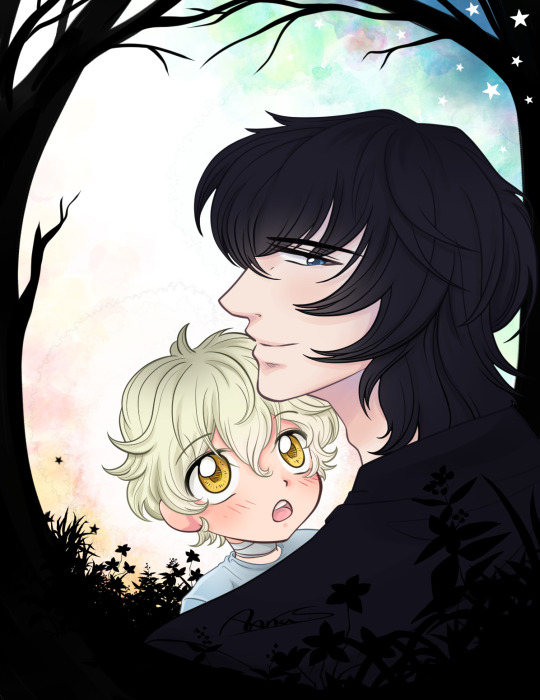
If you are familiar with my blog and the content I enjoy, you might know that I have two very big weaknesses: Cuteness and Horror. They are my aesthetic. Combine the two in a way that doesn’t take away from one or the other, and I’m instantly sold.
One particularly morbid hyperfixation of mine it’s a perfect example of this: The manga Happy Sugar Life, by Tomiyaki Kagisora. It’s about a mentally unstable teenager girl (Satou) who becomes obsessed with a little girl named Shio. Thinking that this obsession must be “love”, she abducts the child and keeps her locked away on their shared appartment, while also trying to “protect” her from those that search to destroy “their happy sugar life” together. This includes pedophiles and people who are as messed-up in the head as Satou herself, but that also includes Asahi, Shio’s older brother, who just wants to discover what happened to her missing sister and save her.
While the main character was almost completely devoid of morals and the plot itself can seem a little icky, to say the least, I was immediately enthralled by the aesthetics, the pretty artstyle and the psychological horror aspects of the plot. The combination of the cutesy atmosphere and traumatized characters, plus the theme of “children in danger” that I love so much in horror, made me love the story.
A saving grace was that, while Satou’s “romantic” obsession with Shio had pedophilic red flags everywhere (No people, you can call it a “motherly bond” all you want, she still kissed an underage child on the mouth and wanted to marry her. No mother figure on their right mind does that!), their... relationship was strictly non-sexual. Still, when it was over it left me hungry for a similar story, one with similar themes but preferably without the child grooming.
At SmackJeeves, main home for nearly all amateur webcomics, I found this little hidden gem titled Silver Tears. And because it’s just three chapters long so far and absolutely no one else is talking about it, I will!
Plot, art and general thoughts under the cut:
Plot
“The 320 year-old vampire Aled Winter finds a severely injured and frightened werewolf child in the middle of the forest. Despite the hateful relations between the vampires and werewolves, Aled chose to save the child's life.”- Plot description on the website.
Silver Tears takes place in a Urban Fantasy world where vampires and werewolves exist alongside humanity. Elves and demons are also mentioned by some characters, with the latter being already implied to having a role on the events behind the plot, but both species have yet to make an appearance.
The plot begins when, after a night of hunting, our main character Aled and his friend Chika spot a mysterious young man wearing a hoodie and with his face covered in blood. Fearing that the guy could be a Revenant (A vampire who has lost their human soul and has become a feral monster), Chika goes after him before he hurts anyone else while Aled goes the opposite way to find the prey the suspected Revenant left behind― And if it is still alive, kill it. Leaving no human witnesses seems to be the modus operandi of vampires in this world, at least when it comes to Revenants.
What he finds instead is a werewolf child, no older than four years, who has been left for dead after the hooded vampire sexually molested him. Despite the very strong discrimination between werewolves and vampires, Aled can’t bring himself to kill the poor boy and decides to rescue him. After he and Chika escape the hooded man (Who is shown to be a humanoid abomination of sorts that leaves even Chika, who is stated to be 2026 years old and a “Queen” of some kind, terrified), he takes the boy back with him to the home he shares with some other vampires and decides to take care of him, despite being told that if it is found out that he has a werewolf child in his custody (and a severely scarred one at that), it would change the already hateful relationship between vampires and werewolves for the worse, and both sides would clearly end-up wanting his head on a plate.
Meanwhile, the hooded man is still on the loose...
Who is that monster? Where and how did he got this boy? Where is the boy’s family? And who exactly is this boy to begin with?
My opinions:
On her notes, the author mentions that she was inspired to draw this comic after writing an essay against the sexual exploitation of children, and it shows. So if you are fearing that this is a comic about a twisted “romance” between a young adult and a child, rest easy because I don’t really think the plot is going on that direction.
Everything else though,like the ever present feeling of dread, the wholesome cuteness of the poor child who’s the center of this whole mess, the mentally disturbed characters, the grey morality... This webcomic has everything I loved in Happy Sugar Life and some more. If I were to describe this comic from the three chapters we got so far, it would be “Gender-bender Happy Sugar Life with fantasy and without pedophilia”. And I don’t know about you, but that’s a complete win for me!
There this enthralling mystery surrounding the two main characters: Aled and the child (Nicknamed by Aled as “Ulv”, since he can’t tell him his own name because of what could be selective muteness, if he had one to begin with). We don’t know absolutely nothing about Ulv’s past, and since he doesn’t seem to be able to talk he can’t give any important information himself. Aled, meanwhile, seems to have been a victim of rape himself in the past, if his shadowy flashbacks are any indication. In any case, he doesn’t take Ulv’s situation lightly, and we are shown that he is willing to kill to keep him safe.
The gray morality is strong on this one: While our main characters are shown to be seemingly good people, they also don’t think much on human life or, in some cases, the lives of even those of their own kind. As an example, when Aled and Chika leave some unnamed human guy unconscious in an alley after feeding from him, When Chika questions if it’s okay to just leave him there, since he could die from the blood-loss and the cold, Aled just hand-waves it and says that he doesn’t think so, but that “no one would miss him” if he did. Maybe his family would, but no one else. Chika accepts this, and they keep moving. The dude is never mentioned again. And that’s just the completely spoiler-free example I can think of right now.
All in all, the plot and the characters have been really interesting so far, and I can’t wait to learn more about them and the strange and scary world they live in.
The Art
If the image above wasn’t any indication, the artstyle the comic uses is very manga, even if the strips are still read like a Western webcomic. Said artstyle can get a little amaterur-ish in some panels, and sometimes characters look like they came from the pages of some “How To Draw Manga” book.
Don’t let that fool you, though. While the author admits that she still need to practice some things, the art can get really, really pretty. The body horror, while not Junji Ito-level of creepy, it’s still very well done, and I can’t think of any page of the comic so far that was “bad” or anything like that. The author puts a lot of love into her art, and that love shines on the final product. Some of the pages and panels look like they came from an actual manga.
LOOK AT HOW PRETTY THAT IS: The wolf’s eye, the creepy smiling shadows.. Just, gorgeous.
General thoughts:
I love this webcomic so far. The plot, the characters, the art... Everything.
I recommend everyone to give this comic a chance. And if the author is reading this: Please, keep up the good work. You are doing great.
#Silver Tears (webcomic)#silver tears#webcomic#urban fantasy#manga recommendation#webcomic recommendation#happy sugar life#fantasy#horror#vampires#werewolves
0 notes
Text
Junji Ito is No Longer Human
Osamu Dazai’s No Longer Human is one of postwar Japan’s most enduring novels: its popularity inspired a live-action film and an animated series, as well as manga by Usamaru Furuya (Genkaku Picasso, Lychee Light Club) and Yasunori Ninose. Junji Ito is the latest artist to adapt No Longer Human, this time in the pages of Shogakukan’s Big Comic Original. Given Ito’s propensity for writing characters whose outward appearance belies their true natures, it’s not surprising that he was drawn to Dazai’s story about a young man who gradually descends into madness and despair. There’s no word on whether an American company will license this adaptation, but my money is on a VIZ edition in 2018 or 2019.
MANGA NEWS AND REVIEWS
Say what you will about the Netflix adaptation of Death Note, it sparked reader interest in Tsugumi Ohba and Takeshi Obata’s original story. The brick-sized All-in-One Edition ranked second on BookScan’s Top 20 Graphic Novels list for September 2017. Other strong performers included One-Punch Man, Boruto: Naruto Next Generations, My Hero Academia, and The Life-Changing Manga of Tidying Up. [ICv2]
Seven Seas recently announced the creation of Ghost Ship, a new manga imprint for mature audiences. Look for debut titles To Love Ru and Yokai Girls in December and January, respectively. [Go Manga]
For your reading pleasure: the VIZ editorial staff composed haikus detailing every November release. [VIZ]
In response to North Korea’s most recent missile test, officials in Hokkaido commissioned a manga to teach residents what to do in the event that Kim Jung-Un does, in fact, launch a nuclear attack. [The Guardian]
The latest Kanta on Manga column focuses on Koi to Uso, a “mainstream romantic comedy” with an “Orwellian” premise. (Kodansha has released two volumes in English as Love & Lies.) [Yomiuri Shimbun]
Now that Fairy Tail has ended, Hiro Mashima sat down with Brigid Alverson to reflect on his experience writing this enormously popular series — one that spanned 63 volumes and topped best-seller lists on both sides of the Pacific. If the storyline seemed loose at times, it was; Mashima freely admits that “I honestly didn’t have any of the last scenes of the story in my mind when I started the series. The fact that I didn’t know where the story [was] going was actually the best part about working on this series.” [B&N Sci-Fi & Fantasy Blog]
Good news from Japan: Shogakukan announced that it will publish two unfinished works by the late Jiro Taniguchi. [The Japan Times]
Translator Jocelyn Allen reviews two BL titles with swoon-worthy art: Setona Mizushiro’s Kyuso wa cheese no yume o miru, and Sakae Kusama’s Wandervogel. [Brain vs. Book]
In September, I spoke with journalist Richard Smith for an article he was writing about the state of digital manga publishing in Japan. The article — with a few sound bites from me — looks at the current size of the digital manga market, and weighs the pros and cons of moving from print to digital consumption. [The National]
MOVIE NEWS AND REVIEWS
Serdar Yegulalp posts an in-depth essay on Shusaku Endo’s 1969 novel Silence, which inspired two very different films: one by Endo and Masahiro Shinoda, released in 1971, and one by Martin Scorsese, released in 2016. [Ganriki]
Fresh off the box office success of Thor: Ragnarok, director Taika Waititi told Screen Rant that he would welcome the opportunity to direct another comic book adaptation: Katsuhiro Otomo’s AKIRA. Waititi’s vision for the project included going back to the original source material, rather than the anime, and hiring Asian actors to play the principal characters. I don’t know about you, but I’d see it. [Screen Rant]
By: Katherine Dacey
0 notes